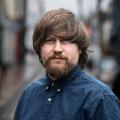
In the run-up to World Aids Day on December 1, The Argus looks back at the history of the HIV/Aids epidemic in Brighton, some 40 years after the virus was first detected in the city.
We spoke to Romany Mark Bruce, the designer and creator of the city’s Aids memorial, about the process of creating the memorial and the loss of his “soulmate” to the virus.
This year marks an important anniversary for Romany Mark Bruce, the sculptor of a memorial that has become the centre for the city’s annual vigil for those who have died from Aids - it is 30 years since his friend Paul Tay died.
Romany, now 62, first met Paul Tay while studying at the University of Leicester in 1979, but it wasn’t until three years later when he saw him in a bar in Earl’s Court that the pair got to know each other properly.
He said: “We became soulmates, very close friends and partners for a while. We were inseparable.”
However, after ten years together, Romany faced weeks where Paul did not return his calls.
He said: “I hadn’t heard from him for about three weeks and he just turned up and said ‘You’ll never guess what I’ve got’, and he told me he had Aids.
“We never discussed his diagnosis or his illness after that first day - that was his way of dealing with it.”

Romany made the trip every other day from Brighton to visit Paul at his mother’s flat in Kingston-upon-Thames, and later at an HIV ward at Middlesex Hospital.
He said that a huge stigma around HIV and Aids was around at the time and that people would look at the pair if they were affectionate or touching other, particularly as Paul had lesions on his skin - caused by Kaposi’s sarcoma, a condition common in people with HIV and Aids.
Romany said: “It was very obvious to people what his illness was and I can remember people just staring at us in the street when we hugged. It felt very awkward.
Paul died less than a month before his 33rd birthday, ten months after he was diagnosed, in May 1992.
“Even after all this time, it is quite difficult,” he said.
READ MORE: 'We can stop it in this decade' - Lloyd Russell-Moyle on living with HIV
Several years later in 2005, former councillor and founder of the Rainbow Fund Paul Elgood came up with the idea of having a memorial for those who had died of Aids in Brighton, as well as those affected by the virus in the city.
Romany was approached by the late James Ledward, former editor of LGBTQ+ magazine Gscene, and encouraged him to submit a proposal for the memorial.
He said: “James Ledward stopped me in the street, jabbed a finger at me and told me he wanted to have a word with me. He told me he wanted me to enter the competition - I didn’t realise there had been a competition running for it.
“I only had ten days to put in my proposal, which I did - and I did it in Italy.
"I happened to be visiting Pietrasanta - the centre of the stone-carving industry. I was surrounded by great inspiration there.
“I come from near Belfast and I was aware that there is a statue to commemorate The Troubles that is very distressing. It is of a woman essentially being blown up.
“I wanted this to be a positive memorial.”

His initial proposal was around five feet tall, as he didn’t know how much of a budget there would be for the memorial but, as money poured in, Romany was able to create a larger memorial.
Describing the sculpture, he said: “It is of two figures - one represents a male and one represents all other sexes. Their paths have crossed and if you follow the trajectories of the two figures you’re never really sure if they meet again as they rise upwards.
“It’s powerful for me, as it is for others, as it brings back memories of somebody very special.”
The construction of the sculpture was not without its challenges, however.
He said: “One day, in the middle of a cow shed where I was making it, I just realised it was all moving - it just fell around me.
“I had to start again and lost three or four months of work, but it didn’t really bother me as I was so happy to be doing it.”

The sculpture in New Steine Gardens was unveiled in October 2009 by David Furnish, husband of Elton John, and soon became a focal point for reflection and remembrance every World Aids Day.
Romany said: “I was lucky, in a sense, that I only had one close friend die, but I am just eternally grateful to Paul because he enabled me to do this.”
On a stone column holding the sculpture in place is a plaque, with the statue’s name - Tay.



Comments: Our rules
We want our comments to be a lively and valuable part of our community - a place where readers can debate and engage with the most important local issues. The ability to comment on our stories is a privilege, not a right, however, and that privilege may be withdrawn if it is abused or misused.
Please report any comments that break our rules.
Read the rules here